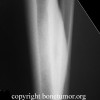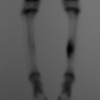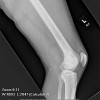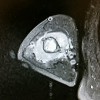Summary
These are non-neoplastic lesions (that is to say, not true tumors) that may look and act like bone tumors. The difference may not be important to the patient, since these problems are just as "real" as real bone tumors.
Three common syndromes mistaken for tumors are Gout, Stress Fractures and Pigmented Villonodular Synovitis.
Complete Information on this Tumor
These are non-neoplastic lesions (that is to say, not true tumors) that may look and act like bone tumors. The difference may not be important to the patient, since these problems are just as "real" as real bone tumors.
Three common syndromes mistaken for tumors are Gout, Stress Fractures and Pigmented Villonodular Synovitis.
Gout
Gout is a disease caused by high levels of Uric Acid in the bloodstream. Crystals of uric acid are deposited on the articular cartilage of the joints causing stiffness and painful episodes of acute arthritis. Gout may present in an atypical patient or in an atypical location in the foot so that the clinician does not include gout in the differential. In these unusual cases the diagnosis may be overlooked even when the clinical picture is typical of gout.
Stress Fracture
Some patients will present with pain and an early stress fracture without any history of prolonged activity or walking. Children may not be able to give a history that is sufficient for the clinician to consider stress fracture in the differential. Plain radiographs may also be misinterpreted.
Pigmented Villonodular Synovitis
PVNS may cause cystic bone lesions that mimic a neoplastic process.
The radiological appearance may mimic an aggressive tumor, with poorly marginated focal bone destruction and an associated soft tissue mass. These findings on the plain radiograph then lead to an MRI scan which can further overstate the worrisome features of the lesion. The radiologist, not having any information about the clinical presentation, then adds malignant tumor to the lengthy list of possibilities in the report. It is sufficient to realize that the "tumor" may be a gouty lesion in order to begin the standard diagnostic process.
Stress Fracture
Plain radiographs may also be misinterpreted. In the early stages the radiographic features of stress fracture are not present. There may be a vague, partially mineralized mass which can be mistaken for a tumor. An MRI at this early stage further confounds the diagnosis, since the early callus around the lesion has signal characteristics identical to tumor. A bone scan may or may not demonstrate the characteristic narrow, transverse band of intense tracer uptake at the site of the fracture. In the author's experience, by the time a number of radiographic studies have been done and the patient is referred to a tumor specialist for evaluation, the plain radiograph features have evolved to the point that the diagnosis is no longer in doubt.
Pigmented Villonodular Synovitis
Careful analysis of the radiographs or MRI images reveals that the lesion is based in the joint. Bone cysts occurring on both sides of the joint are highly likely to be caused by PVNS. Certain MRI scanning sequences can reveal the inky black blotches around the lesions that are caused by the presence of hemosiderin.









